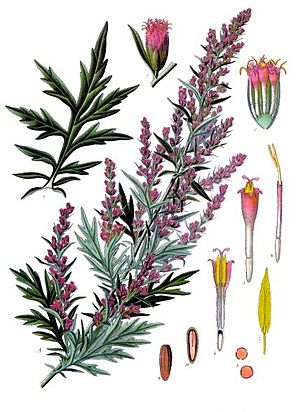Mugwort facts for kids
Mugwort is a common name for several types of fragrant flowering plants. These plants belong to the Artemisia group. In Europe, when people say "mugwort," they usually mean Artemisia vulgaris, also known as common mugwort. Other plants in the Artemisia group might also be called mugwort, even if they have more specific names.
Contents
What's in a Name?
The name "mugwort" has a long history. It comes from old words like the Anglo-Saxon "mucgwyrt." Some people think the name might be linked to the word "mug" because it was used to flavor drinks a very long time ago.
Other ideas suggest it comes from Old Norse words meaning "marsh" and "root." This might be because mugwort was used to keep insects like moths away. The "wort" part of the name simply means "plant" or "herb."
Different Kinds of Mugwort
Many different plants in the Artemisia group are called mugwort. Here are some of them:
- Artemisia absinthium – This is wormwood, famous for being used in a drink called Absinthe.
- Artemisia argyi – Known as Chinese mugwort, it's used in traditional Chinese medicine.
- Artemisia douglasiana – Called Douglas or California mugwort, it grows in western North America.
- Artemisia princeps – This is Korean mugwort (ssuk) and Japanese mugwort (yomogi). People use it in cooking and traditional medicine.
- Artemisia vulgaris – This is common mugwort. It's used as a cooking herb and for health purposes around the world.
How People Use Mugwort
Mugwort has many uses! It contains natural oils. One of these oils, called thujone, can be harmful if too much is used. So, it's important to be careful with mugwort.
The soft, fuzzy hairs found under the leaves can be collected and used to start fires. This is because they catch fire easily. All parts of the mugwort plant have oils that can help keep insects away, especially young insect larvae.
Mugwort in Food
The leaves and buds of mugwort can be picked in summer and used to add a slightly bitter taste to food. It's often used with fatty meats and fish. Long ago, before hops became popular, mugwort was even used to flavor beer!
Mugwort Oils
The natural oils in mugwort can be different depending on where the plant grows, which part of the plant is used, and when it's picked. These oils can contain many different things, like camphor and cineole.
Mugwort in History
In the Middle Ages in Europe, people thought mugwort had special powers. They used it to protect themselves from evil spirits and wild animals. Roman soldiers would put mugwort in their sandals to help their feet feel less tired during long marches.
Mugwort is even mentioned in an old Anglo-Saxon poem from the 10th century called the Nine Herbs Charm. People also believed that wearing mugwort on St. John's Eve (a special day) could protect them from sickness and bad luck.
On the Isle of Man, mugwort is called bollan bane. People still wear it on their clothes during the Tynwald Day celebrations, which are also linked to St. John.
Mugwort in Asia
Mugwort is very popular in Asian cooking and traditional practices.
China
In China, mugwort has been used in cooking for a very long time. Famous Chinese poets mentioned it in their writings centuries ago. It's often called lóuhāo or àicǎo. People stir-fry it with meat or make it into cold dishes. The Hakka people in Taiwan use it to make sweet dumplings called chhú-khak-ké.
In traditional Chinese medicine, dried and aged mugwort, called moxa, is burned near specific points on the body. This practice is called moxibustion and is believed to help with various health issues.
Japan
In Japan, mugwort is known as yomogi. It's used in many Japanese foods, like yōkan (a dessert) and kusa mochi (rice cakes). Kusa mochi are often used to make daifuku, which are small, sweet rice cakes filled with fruit or sweet bean paste.
Yomogi is also an important part of special foods served during the Doll Festival in March. Japanese people also use the fuzz from mugwort leaves for moxibustion, similar to China. Some regions in Japan hang yomogi and iris leaves outside their homes. They believe the smell keeps evil spirits away.
Korea
In Korea, mugwort is called ssuk. It's used in soups and salads. A traditional spring soup is ssukguk, made with young mugwort plants. Another dish, ssukbeomul, mixes mugwort with rice flour and then steams it.
Ssuk is a common ingredient in Korean rice cakes, teas, and pancakes. It's believed to have different health benefits depending on where it's grown. In traditional Korean medicine, ssuk is also used for moxibustion. People from the Joseon Dynasty even used mugwort water to clean themselves.
Mugwort and Allergies
For some people, mugwort pollen can cause hay fever and allergic asthma. This is common in parts of Europe, North America, and Asia. Mugwort pollen usually doesn't travel very far. Tearing up mugwort plants can help reduce the amount of pollen in the air, which can lessen allergy symptoms.
Mugwort for Health
Mugwort has been used in traditional medicine for a long time. In Ayurveda, an ancient Indian system of medicine, it's used for heart problems and general feelings of being unwell.
In traditional Chinese medicine, some believe that using moxibustion with mugwort can help babies turn into the correct position before birth if they are in a breech position.
Mugwort is especially important in traditional Chinese, Japanese, and Korean medicine. Different species are used, like Chinese mugwort (Artemisia argyi) and Korean mugwort (Artemisia princeps). Native peoples of North America also used mugwort for various health purposes.



